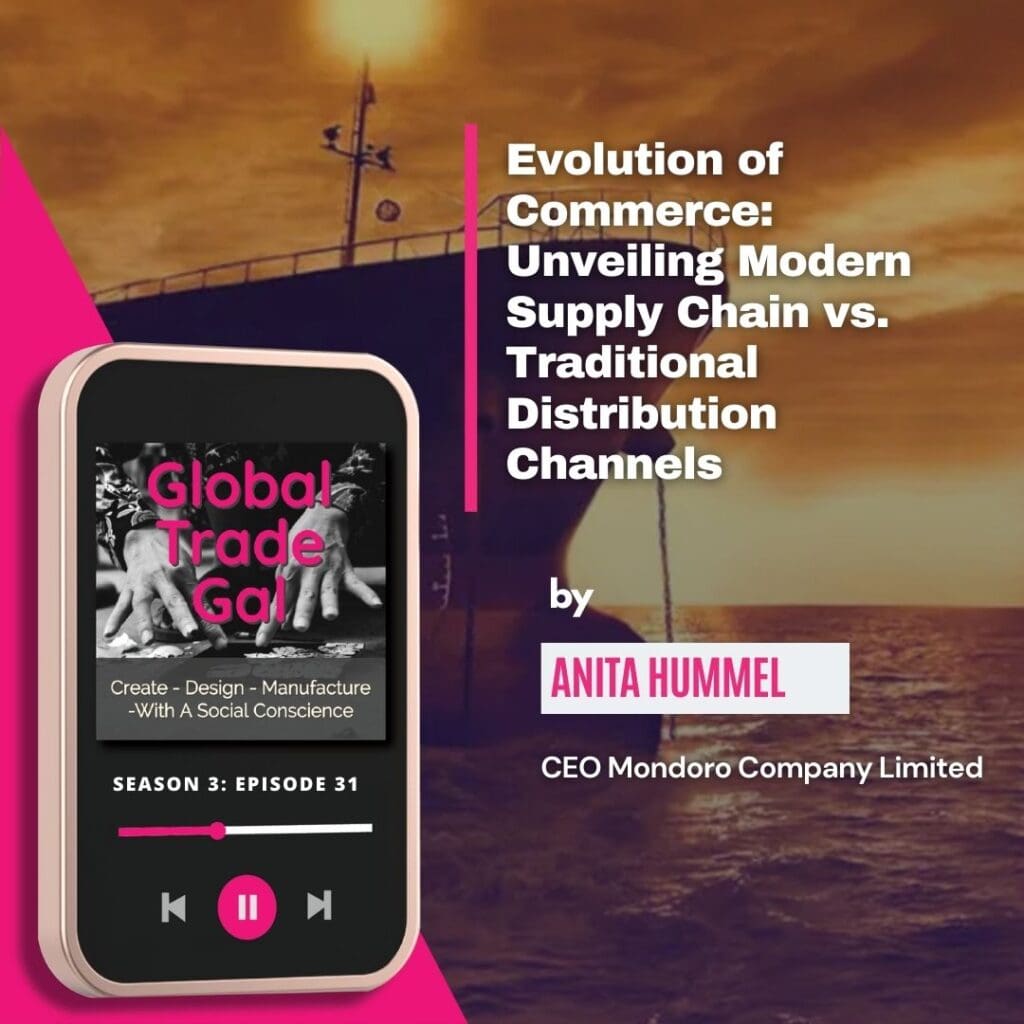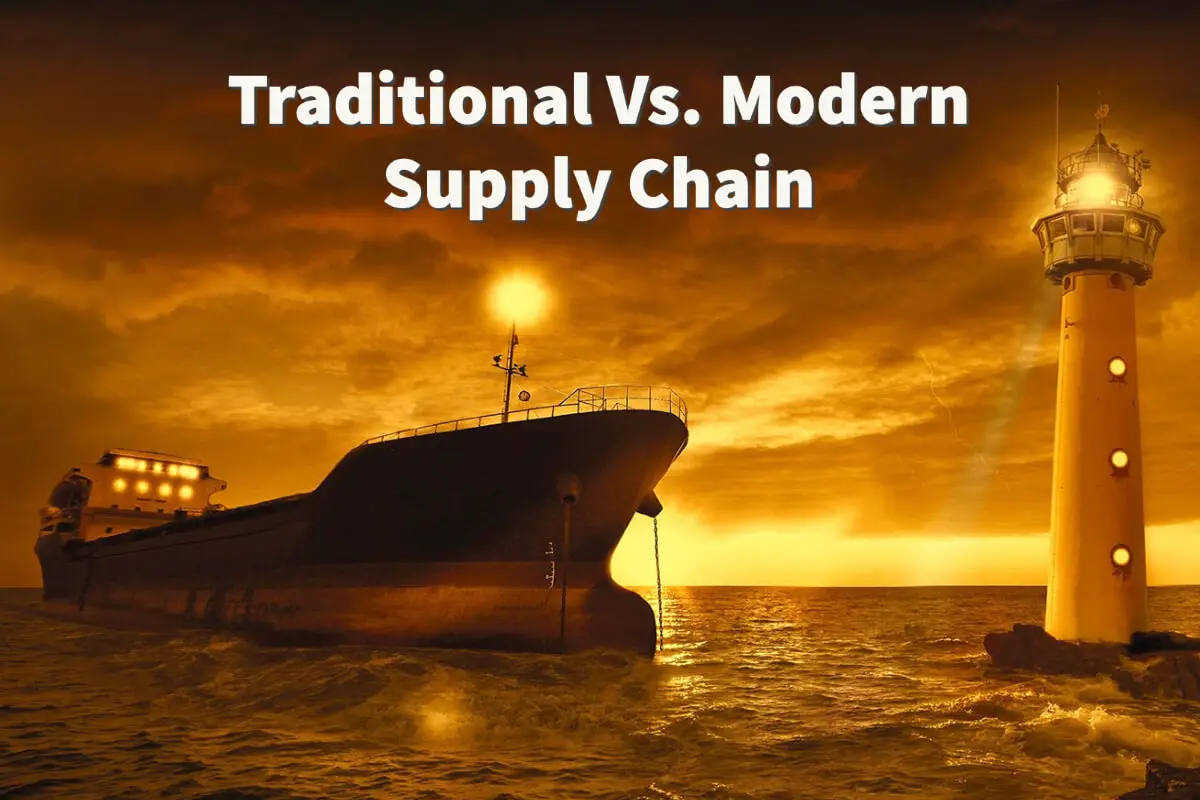When looking at the supply chain, many people ask themselves the difference between modern and traditional supply chains. This is because, over the years, supply chain management has undergone many changes.
The traditional distribution channel, or the traditional supply chain, is what many of us think about when we think of a supply chain; it brings goods from the raw material to the end product and then to the consumer. With the onset of technology, the supply chain has changed to the Modern Supply Chain. The Modern Supply Chain focuses more on the customers and forming alliances and partnerships.
Table of Contents
- Traditional Distribution Channels
- Modern Supply Chain
- Modern Supply Chain Vs. Traditional Distribution Channels
- Frequently Asked Questions
- Related Content
Traditional Distribution Channels
Traditional distribution or supply chain management is the supply chain that many of us know or think about when we think about supply chain management. This supply chain distribution channel has been used for many years. It is a traditional distribution channel, supply chain management, or SCM.
The traditional distribution channel focuses on five significant steps in the supply chain. Here are the five basic steps:
- Procurement of Raw Materials – First, the raw materials are procured to produce and make the product. This can be internal in that the company is making the goods themselves or external in that someone else is making the product for them, and they are buying the finished product.
- Raw Materials To Manufacture – Next, the raw materials are sent to the manufacturer so that the products can be produced. In this case, the raw materials can be locally procured, imported, or combined.
- Manufacturing – Now that the raw materials have all been procured, the goods are ready to be manufactured. The manufacturer produces the products until the finished product is completed and ready to be shipped.
- Shipment and Distribution – The goods are shipped to the wholesaler or distributor. This can be local if the goods are produced locally or overseas if they are export products. This phase is usually the shipment, distribution, and warehousing.
- Sold To End Consumer – The good is sold to the end consumer who will use the goods. The end consumer can take them home with them, as would be the case for purchasing retail, or the goods could be delivered to the end consumer by another method.
The traditional distribution or supply chain focuses on how the products go from raw material to the end consumer. This is all about getting the raw materials made into a product that is then shipped and ultimately put into the hands of the end-user or customer.
Modern Supply Chain
As technology has become the focal point of the supply chain has become a more modern supply chain. Today, the supply chain is known as the modern supply chain or modern SCM.
Here are some things the Modern Supply Chain or Modern SCM is focused on:
- Use of Technology – At the center of the Modern Supply Chain is technology. This is because now at the forefront of the supply chain is the use of technology and how the technology is used throughout the entire supply chain.
- Logistic Management – The Modern Supply Chain uses logistics management, a system that allows the process to plan, implement and control the flow of goods. Today logistic management is a standard tool used by all freight forwarders and shipping companies worldwide.
- Partnership Focus – The modern supply chain is all about building partnerships, collaborations, and alliances to help ensure that the supply chain is the best possible. This is because it is no longer just a standalone supply chain; the modern supply chain is about partnerships, alliances, and collaborations.
- Customer Focus – The modern supply chain is also customer focus. Each person in the supply chain understands the customer is essential. In other words, each area of the modern supply chain is focused on the customer and the customer’s needs.
- Service and Speed Oriented -The modern supply chain also focuses on service and speed. Everything from the raw material supplier to the manufacturer to the distributor has a goal to ensure that the goods arrive promptly.
At the heart of the modern supply chain is the use of technology. Technology has changed us in ways we may not realize or understand entirely. The supply chain is an example of how technology has helped the overall processes in the supply chain to be more collaborative, partner-focused, and efficient.
Modern Supply Chain Vs. Traditional Distribution Channels
In comparing the modern supply chain with the traditional supply chain, the modern supply chain is more multi-focused, while the traditional supply chain is a more single-focused process. In other words, the modern supply chain is focused on a more continuous partnership that delivers repeatedly.
The traditional supply chain or distribution channel focuses on bringing the raw material to the manufacturer and the end consumer. It was more like a single-line focus than a multi-line focus.
Supply chain management is a great example of how technology has changed the supply chain. Most of us, myself included, have moved from the traditional supply chain to the modern one without considering its implications. This is because the world has moved at such a fast pace with technology and the advances of technology that we have had to move along with it to survive.
We have all had to change to survive in any part of this modern supply chain. We have had to change our focus, how we use technology, and how we use the supply chain we are involved in.
Listen To Our Podcast About The Evolution of Commerce: Unveiling Modern Supply Chain vs. Traditional Distribution Channels Below or by clicking here.

Find out more about how Mondoro can help you create, develop, and manufacture excellent home decor and furniture products – don’t hesitate to contact me, Anita. Check out my email by clicking here or become a part of our community and join our newsletter by clicking here.
Mondoro gives out a FREE Lookbook to anyone interested. You can receive a copy of our latest Lookbook by clicking here.
Listen to our Podcast called Global Trade Gal. You can find it on all major podcast platforms. Try out listening to one of our podcasts by clicking here.
Subscribe to our Mondoro Company Limited YouTube Channel filled with great videos and information by clicking here.
Frequently Asked Questions
What is a traditional supply chain?
A traditional supply chain refers to the traditional distribution channel that brings goods from raw materials to the end product and finally to the consumer. It follows a linear path from suppliers to manufacturers to distributors and retailers.
What is a modern supply chain?
A modern supply chain is an evolved approach that focuses more on customer-centricity and forming alliances and partnerships. It emphasizes collaboration, agility, and leveraging technology to enhance efficiency and responsiveness throughout the supply chain.
What are the key differences between a traditional and modern supply chain?
In a traditional supply chain, the focus is primarily on product delivery and cost efficiency, while a modern supply chain places greater emphasis on customer satisfaction, flexibility, and adaptability. Modern supply chains also leverage technology, data analytics, and collaborative relationships to enhance visibility and optimize processes.
How does a modern supply chain prioritize customer needs?
A modern supply chain recognizes the importance of meeting customer expectations and tailoring products and services to their needs. It emphasizes gathering customer insights, implementing demand-driven strategies, and providing personalized experiences to enhance customer satisfaction and loyalty.
How does technology influence the modern supply chain?
Technology plays a significant role in the modern supply chain by enabling real-time data sharing, automation, advanced analytics, and connectivity across the supply network. It facilitates efficient inventory management, demand forecasting, and logistics optimization and enhances visibility and transparency throughout the supply chain.
What are the advantages of adopting a modern supply chain approach?
Adopting a modern supply chain approach offers numerous benefits, such as improved customer satisfaction, increased agility and responsiveness to market changes, reduced costs through streamlined processes, enhanced visibility and traceability, and better collaboration with partners and suppliers.
How does collaboration and partnerships contribute to a modern supply chain?
Collaboration and partnerships are essential in a modern supply chain as they enable closer relationships with suppliers, customers, and other stakeholders. By collaborating, sharing information, and aligning goals, organizations can achieve better coordination, synchronized planning, and improved overall efficiency.
How does a modern supply chain handle disruptions and uncertainties?
A modern supply chain is designed to be resilient and responsive to disruptions and uncertainties. By leveraging real-time data and analytics, it can quickly identify potential risks, implement contingency plans, and adjust operations to minimize the impact of disruptions, ensuring continuity and customer satisfaction.
Related Content
How Do You Load A Dry Shipping Container?
A dry shipping container is a container that is used for 90% of all shipments worldwide. The dry shipping containers’ standard sizes are 20’, 40’, and 40’ HC container sizes. Each size has different payload weights and loading size limits, so when you prepare to load your container, the size you choose will make a massive difference in the actual container loading.
To find out more about loading a dry shipping container, you can read our blog on 10 Tips On Loading A Dry Shipping Container, What You Need To Know by clicking here.
What Is The DUPRO or During Production Inspection?
The DUPRO Inspection is a product inspection conducted during the manufacturing phase of production. The DUPRO is also known as during the production inspection, as its main purpose is to find any errors during the product’s manufacturing phase. Most manufacturing errors are easier to fix during production than when the goods are completed.
You can find out more about the DUPRO by reading our blog DUPRO, During the Production Product Inspection Guide by clicking here.


